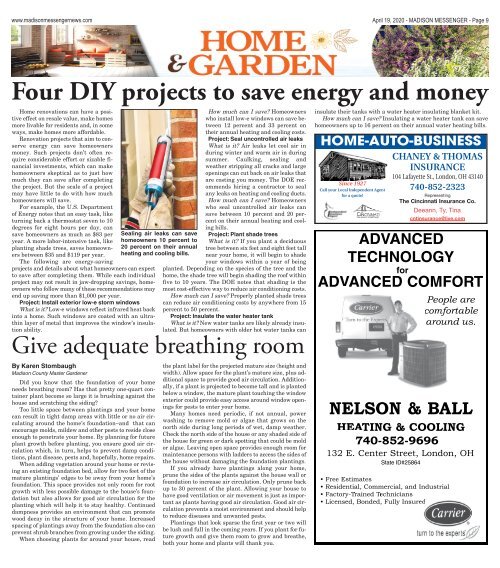Madison Messenger - April 19th, 2020
You also want an ePaper? Increase the reach of your titles
YUMPU automatically turns print PDFs into web optimized ePapers that Google loves.
www.madisonmessengernews.com <strong>April</strong> 19, <strong>2020</strong> - MADISON MESSENGER - Page 9<br />
Four DIY projects to save energy and money<br />
Home renovations can have a positive<br />
effect on resale value, make homes<br />
more livable for residents and, in some<br />
ways, make homes more affordable.<br />
Renovation projects that aim to conserve<br />
energy can save homeowners<br />
money. Such projects don’t often require<br />
How much can I save? Homeowners<br />
who install low-e windows can save between<br />
12 percent and 33 percent on<br />
their annual heating and cooling costs.<br />
Project: Seal uncontrolled air leaks<br />
What is it? Air leaks let cool air in<br />
during winter and warm air in during<br />
considerable effort or sizable fi-<br />
summer. Caulking, sealing and<br />
nancial investments, which can make<br />
homeowners skeptical as to just how<br />
much they can save after completing<br />
the project. But the scale of a project<br />
may have little to do with how much<br />
homeowners will save.<br />
For example, the U.S. Department<br />
of Energy notes that an easy task, like<br />
turning back a thermostat seven to 10<br />
degrees for eight hours per day, can<br />
save homeowners as much as $83 per<br />
year. A more labor-intensive task, like<br />
Sealing air leaks can save<br />
homeowners 10 percent to<br />
weather stripping all cracks and large<br />
openings can cut back on air leaks that<br />
are costing you money. The DOE recommends<br />
hiring a contractor to seal<br />
any leaks on heating and cooling ducts.<br />
How much can I save? Homeowners<br />
who seal uncontrolled air leaks can<br />
save between 10 percent and 20 percent<br />
on their annual heating and cooling<br />
bills.<br />
Project: Plant shade trees<br />
What is it? If you plant a deciduous<br />
planting shade trees, saves homeowners<br />
between $35 and $119 per year. heating and cooling bills. near your home, it will begin to shade<br />
20 percent on their annual tree between six feet and eight feet tall<br />
The following are energy-saving<br />
projects and details about what homeowners can expect<br />
to save after completing them. While each individual<br />
project may not result in jaw-dropping savings, homeowners<br />
who follow many of these recommendations may<br />
end up saving more than $1,000 per year.<br />
Project: Install exterior low-e storm windows<br />
What is it? Low-e windows reflect infrared heat back<br />
into a home. Such windows are coated with an ultrathin<br />
layer of metal that improves the window’s insulation<br />
ability.<br />
your windows within a year of being<br />
planted. Depending on the species of the tree and the<br />
home, the shade tree will begin shading the roof within<br />
five to 10 years. The DOE notes that shading is the<br />
most cost-effective way to reduce air conditioning costs.<br />
How much can I save? Properly planted shade trees<br />
can reduce air conditioning costs by anywhere from 15<br />
percent to 50 percent.<br />
Project: Insulate the water heater tank<br />
What is it? New water tanks are likely already insulated.<br />
But homeowners with older hot water tanks can<br />
Give adequate breathing room<br />
insulate their tanks with a water heater insulating blanket kit.<br />
How much can I save? Insulating a water heater tank can save<br />
homeowners up to 16 percent on their annual water heating bills.<br />
HOME-AUTO-BUSINESS<br />
CHANEY & THOMAS<br />
INSURANCE<br />
Since 1927<br />
Call your Local Independent Agent<br />
for a quote!<br />
104 Lafayette St., London, OH 43140<br />
740-852-2323<br />
Representing<br />
The Cincinnati Insurance Co.<br />
ADVANCED<br />
TECHNOLOGY<br />
for<br />
Deeann, Ty, Gloria, Ty, Tina Tina<br />
cntinsurance@live.com<br />
ADVANCED<br />
ANCED COMFORT<br />
People are<br />
comfortable<br />
around us.<br />
By Karen Stombaugh<br />
<strong>Madison</strong> County Master Gardener<br />
Did you know that the foundation of your home<br />
needs breathing room? Has that pretty one-quart container<br />
plant become so large it is brushing against the<br />
house and scratching the siding?<br />
Too little space between plantings and your home<br />
can result in tight damp areas with little or no air circulating<br />
around the home’s foundation—and that can<br />
encourage molds, mildew and other pests to reside close<br />
enough to penetrate your home. By planning for future<br />
plant growth before planting, you ensure good air circulation<br />
which, in turn, helps to prevent damp conditions,<br />
plant disease, pests and, hopefully, home repairs.<br />
When adding vegetation around your home or revising<br />
an existing foundation bed, allow for two feet of the<br />
mature plantings’ edges to be away from your home’s<br />
foundation. This space provides not only room for root<br />
growth with less possible damage to the house’s foundation<br />
but also allows for good air circulation for the<br />
planting which will help it to stay healthy. Continued<br />
dampness provides an environment that can promote<br />
wood decay in the structure of your home. Increased<br />
spacing of plantings away from the foundation also can<br />
prevent shrub branches from growing under the siding.<br />
When choosing plants for around your house, read<br />
the plant label for the projected mature size (height and<br />
width). Allow space for the plant’s mature size, plus additional<br />
space to provide good air circulation. Additionally,<br />
if a plant is projected to become tall and is planted<br />
below a window, the mature plant touching the window<br />
exterior could provide easy access around window openings<br />
for pests to enter your home.<br />
Many homes need periodic, if not annual, power<br />
washing to remove mold or algae that grows on the<br />
north side during long periods of wet, damp weather.<br />
Check the north side of the house or any shaded side of<br />
the house for green or dark spotting that could be mold<br />
or algae. Leaving open space provides enough room for<br />
maintenance persons with ladders to access the sides of<br />
the house without damaging the foundation plantings.<br />
If you already have plantings along your home,<br />
prune the sides of the plants against the house wall or<br />
foundation to increase air circulation. Only prune back<br />
up to 30 percent of the plant. Allowing your house to<br />
have good ventilation or air movement is just as important<br />
as plants having good air circulation. Good air circulation<br />
prevents a moist environment and should help<br />
to reduce diseases and unwanted pests.<br />
Plantings that look sparse the first year or two will<br />
be lush and full in the coming years. If you plant for future<br />
growth and give them room to grow and breathe,<br />
both your home and plants will thank you.<br />
NELSON<br />
& BALLL<br />
HEA<br />
ATING<br />
& COOLING<br />
740-852-9696<br />
132 E. Center Street, London, OH<br />
State ID#25864<br />
• Free Estimates<br />
• Residential, Commercial, and Industrial<br />
• Factory-Trained<br />
rained Technicians<br />
• Licensed, Bonded, Fully Insu


















